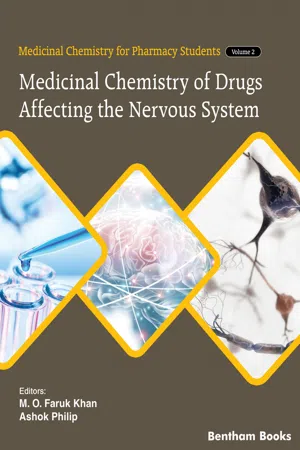Parkinson Disease and Antiparkinsonian Drugs
Ashok E. Philip1, *, George DeMaagd2, M. O. Faruk Khan3 1 Department of Pharmaceutical Sciences, Union University School of Pharmacy, Jackson, TN38305, USA
2 Department of Pharmacy Practice, Union University School of Pharmacy, Jackson, TN38305, USA
3 School of Pharmacy, University of Charleston, Charleston, WV 25304, USA
Abstract
This chapter is a comprehensive account of Parkinson's disease and the medicinal chemistry of antiparkinsonian drugs. It provides the mechanism of disease progression and drug action and detail structure-activity relationships of the antiparkinsonian drugs to give the knowledge base for pharmacists. After a study of this chapter, students will be able to:
• Discuss the epidemiology and etiology of Parkinson disease (PD)
• Describe the clinical features of idiopathic PD and differentiate between cardinal motor features and non-motor symptoms
• Discuss various risk factors and corresponding mechanisms responsible for the development of PD symptoms
• Review biosynthesis of dopamine, its metabolic outcomes, dopaminergic pathways, receptor distribution and corresponding signal transduction mechanisms
• Explain in detail the pathophysiologic mechanisms responsible for the clinical features of idiopathic PD
• Evaluate the clinical role of L-DOPA and discuss its mechanism of action, pharmacokinetics, adverse effects, motor complications, drug interactions, contraindications and precautions
• For each medication class listed below, discuss their mechanism of action, pharmacokinetics, adverse effects, motor complications, drug interactions, contraindications and precautions
o Dopamine agonists
▪ ropinirole (Requip®, Requip® XL); pramipexole Mirapex®, Mirapex® ER); rotigotine transdermal patch (Neupro®), and apomorphine (Apokyn®)
o Catechol-O-methyltransferase (COMT) inhibitors
▪ entacapone (Comtan®) and tolcapone (Tasmar®)
o Selective monoamine oxidase-B (MAO- B) inhibitors
▪ selegiline (Eldepryl® and Zelapar® ODT) and rasagiline (Azilect®)
▪ amantadine (Symmetrel®)
o Anticholinergic agents (benztropine (Cogentin®) and trihexyphenidyl)
Keywords: Parkinson’s disease (PD), Amantadine, Anticholinergic agents, Antiparkinsonian drugs, Apomorphine, Benztropine, Catechol-O-methyltransferase (COMT) inhibitors, Dopamine (DA), Entacapone, L-DOPA dopamine agonists, Muscarinic agents, Pramipexole, Rasagiline, Ropinirole, Rotigotine, Selective monoamine oxidase-B (MAO-B) inhibitors, Tolcapone, Selegiline, Structure-activity relationshipand drug-receptor.
* Corresponding author Ashok E. Philip: Department of Pharmaceutical Sciences, Union University School of Pharmacy, Jackson, TN, USA; Tel: 731-661-5704; E-mail: [email protected] HISTORICAL BACKGROUND
Parkinson's disease (PD) was first described by Dr. James Parkinson in 1817 as a “shaking palsy.” PD is a chronic progressive neurodegenerative disease characterized by both motor as well as non-motor features. The cardinal motor features of the disease include resting tremor, bradykinesia, muscular rigidity and postural imbalance whereas non-motor symptoms include dementia, depression and others [1, 2]. Please refer to Table 1 for a description of motor and non-motor symptoms associated with PD.
In the United States, PD incidence is reported to be approximately 20 cases per 100,000 people per year (60,000 per year), with the mean age of onset close to 60 years. Overall, approximately 1 million Americans are currently affected by PD. The prevalence is reported to be approximately 1-2% in the 60 and > age group and increases to 1-3% in the 80 plus age group [3-6]. However, even though PD is primarily a disease of the elderly, reports indicate that patients may develop this disease in their 30s and 40s [4]. Also, the incidence of PD is reported as a ratio of 3:2 (male to female) with a recent study suggesting that the potential delayed onset in females could be related to interactions between gonadotropins and the nigrostriatal dopaminergic system [7, 8].
In 1867, Ordenstein introduced belladonna to treat Parkinson's disease. However, its use fell out of favor quickly. A series of discoveries of the basic etiology and histology of the disease led to the discovery of modern antiparkinsonian treatments. Levodopa, a dopamine precursor, was introduced in the 1960s after the milestone discovery of PD as a disorder of dopamine metabolism. Bromocriptine and deprenyl (selegiline) were introduced in the 1970s, followed by pergolide in the 1980s. In 1997, pramipexole and ropinirole were introduced as direct dopamine receptor agonists for the treatment of PD. The discovery of many genetic defects throughout the 1990s led to gene therapy for PD in 2005. Rasagiline, a selective MAO-B inhibitor, was approved in 2006 [9, 10].
INTRODUCTORY CONCEPTS
Clinical Overview, Etiology and Risk Factors
The cardinal motor symptoms of PD include:
- Resting tremor (usually resolves with voluntary movement and during sleep)
- Bradykinesia (slowness and decreased amplitude of movement)
- Muscular rigidity (resistance to passive movement of flexor and extensor muscles)
- Postural instability (loss of postural reflexes that lead to falling and gait disturbances)
The extrapyramidal system involves motor structures of basal ganglia and plays a prominent role in maintaining posture, muscle tone and regulating voluntary smooth muscle activity. From a neuropathology perspective, PD is a disorder of the extrapyramidal system with the etiology for motor symptoms attributed to the loss of pigmented dopaminergic neurons (symptoms are seen only at ~80% loss) in the pars compacta region of substantia nigra which project to striatum t...
